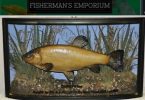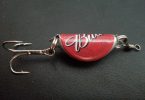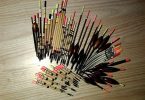A REVIEW OF THE SCIENTIFIC BASIS FOR PIKE CULLS
Preface to article: ‘Pike & The Effects Of Culling’
This article is the latest version of what started as a briefing paper back in the early 1980s. Updated several times, it is intended to provide a factual, dispassionate summary of aspects of the biology of pike and • in particular • what happens when they are culled.
It is not meant to be an easy read full of emotional invective and personal opinions. Its main use is as heavyweight ammunition to use against individuals and organisations who believe that the only good pike is a dead ‘un. The last four PAC committees, to good effect, have employed the paper for just this purpose.
Feel free to use some or all of the information if you get entangled with pike haters or ill-informed fishery managers. Any additional data or ideas for future expansion would be greatly welcomed.
A REVIEW OF THE SCIENTIFIC BASIS FOR PIKE CULLS
– prepared by –
Dr Bruno Broughton
B.Sc. (Hons), Ph.D., F.I.F.M.
Fisheries Management Consultant
P.A.C. Scientific Adviser
Latest Update: 16 September 2000
1.0: General Comments On Management Principles
There are a wide variety of physical, chemical and biological factors which influence fish populations in exploited fisheries. Where both predators and prey are present, factors which increase fish numbers include:-
· immigration
· natural recruitment (successful spawning)
· stocking, be it planned, accidental or illegal.
Factors which decrease fish numbers include:-
· emigration
· pollution
· disease and parasitism
· ‘natural’ mortalities
· predation – by the same species, other fish or other animals
· removals, either deliberate (cropping/culling) or theft
· angling, through deliberate or accidental actions.
In assessing the reason(s) for changes in the status or composition of fish populations it is important that each of these factors is considered. All too often, those charged with managing fisheries draw cause-and-effect conclusions based on prejudice, hearsay or inadequate data. Historically, the persecution of pike in British fisheries was a case in point, based on the fallacious notion that if left to their own devices, the pike would eat all of the other species to extinction.
With improved knowledge and its wider dissemination to anglers, attitudes have changed rapidly in the last few decades. It is fair to state that the far greater protection afforded to pike has not been accompanied by a decline in the quality of fishing for non-pike species.
Were this not the case, there would undoubtedly be a substantial groundswell of angling opinion in favour of rescinding pike conservation measures and resuming widespread pike culls… which there is not. Scientists and anglers in many other countries, notably in some other western European nations and in North America, share this more enlightened attitude to pike.
2.0: Specific & Relevant Scientific Information
The data from numerous sources demonstrate that on stable fisheries there is a weight-to-weight relationship between predatory fish and the prey which are available to them. This finding is in direct agreement with the original assertion of Johnson (1949) and the detailed pond experiments conducted by Swingle (1950). The latter author found that in ponds which maintained a balanced predator/prey relationship over prolonged periods, this ratio usually lies between 1:1.4 and 1:10.
In his review of a large quantity of data derived from eastern European predator fisheries, Popova (1967) cites pike biomasses of 10-13 per cent of that of their available prey; Kell (1985) lists survey data for the Sixteen Foot drain which give a relationship of 12 per cent; and Templeton (1995) recommends that pike fisheries should be stocked with prey fish at a weight of eight times that of the pike. When Broughton (unpublished data) analysed the catch statistics from several hundred scientific surveys of still and running water fisheries in the Midlands, an average weight ratio between pike and their available prey was found to be approximately 1:10.
Using the ratio of 1:10, one can predict that 3001b of prey fish would be able to support some 301b of pike without any long-term, adverse effects on the abundance of either type of fish. A useful analogy is to imagine that the prey fish represent a sum of money which is invested. In effect, pike are consuming the interest, leaving the capital sum untouched.
This balance is a so-called dynamic equilibrium – in other words, it will swing one way or another in response to entirely natural phenomena (such as spawning success or outbreaks of disease). Equally, if the balance swings markedly in favour of one ‘side’, ecological pressures ensure that eventually it will swing back in the other direction (described in detail by Carlander 1958 and Anderson & Weithman 1978).
If this were not the case, there would be countless examples of fisheries in which pike have become dominant or have totally eradicated the stocks of prey fish, and this would be a continuing situation on unmanaged waters. I have reviewed a huge volume of the published scientific literature on pike in the British Isles, Europe, North America and elsewhere, and there appears to be just one example where pike had ‘eaten themselves out of house and home’ (Munro1957).
Ricker (1952) described three types of numerical relationships between predatory fish and their prey. Mann (1982), Kell (1985) and other authors have concluded that pike probably fall into Ricker’s Type B model, in which: “Predators at any given abundance take a fixed fraction of prey species present, as though there were captures at random encounters”. This means that predation is dependant on the numbers of prey, rather than the numbers of predators.
The dietary requirements of pike are also predictable and have been studied by several authors (e.g. Kipling & Frost 1970). In general terms, a diet comprising between 13oz-1lb of prey fish per pound of pike per annum is needed to merely keep the pike alive (the ‘maintenance ration’): Johnson (1966) lists an average figure equivalent to l.41b/lb/year, with a range of 1.3-1.8, whereas Mann (1982) reports an annual value of 0.8/g/g. (Note, however, that there is a positive correlation between food consumed and increasing temperature, and higher values have been recorded for pike kept under unnaturally-warm experimental conditions.)
Where pike are undergoing normal growth, 2-3lb of prey fish per pound of pike per annum is a common ration. For example, in his study of the Middle Level drainage system, Kell (1985) calculated that the annual consumption of prey fish by pike was 254 per cent of their body weight; and Popova (1978) cites studies which revealed figures of 341-344 per cent in the Volga delta and 270-340 per cent in Rybinsk Reservoir.
Conversion from prey flesh to pike flesh can also be predicted and the ratio between weight gain and total food consumed during normal growth is often between 1:5 and 1:10 -Popova (1978) lists a figure of 1:8.8 and Mann (1982) calculated a ratio of 1:6.6.
The selection of prey by pike has been the subject of numerous studies. Some authors have noted that as pike grow larger, they eat larger prey (e.g. Diana 1979), although small prey are still consumed; other authors (e.g. Willemsen 1967) have concluded that it is the relative abundance of prey species which determines the diet of pike. Popova (1967) concluded that prey choice appeared to be governed solely by its availability to pike.
If offered a choice of prey species, there is some evidence that pike may select soft-rayed species in preference to fish bearing spines (Mauck & Coble 1971). However, other authors report that spined fish – usually perch or related species – are the dominant prey of pike (see Johnson 1966, Diana 1979). Flickinger & Clarke (1978) reported heavy predation by newly introduced pike on bluegills (a spined species), whereas there was no change in the numbers of carp and black crappies (soft-rayed and spined species respectively). In Llandegfedd Reservoir, South Wales, analyses of the stomach contents of large pike revealed substantial numbers of perch and relatively few trout (Welsh Water Authority, unpublished data).
That pike tend to be opportunist, rather than selective piscivores is supported by the fact that the stomach contents listed by Frost (1954) and Mann (1982) comprised nearly the entire range of fish species at both studied sites, Lake Windermere and the River Frome. Seasonal changes in the diet of pike do take place in response to the availability of prey (described by Lawler 1965 and many other authors). However, the scientific literature does not support the notion that pike will always ‘prefer’ a particular prey species -irrespective of its abundance – an allegation often levelled at pike in salmonid fisheries.
Kell (1985) concluded that recruitment to the pike population is largely determined by survival of the younger stages in the life cycle, rather than the number of parents or the quantity of spawn which is shed, with predation and starvation being the prime causes of larval mortality. Clepper (1975) also failed to identify any correlation between the size of the spawning stock and subsequent year-class strength for a variety of predatory fish, including pike.
The extent of intraspecific (pike on pike) predation has been noted by many authors (e.g. Toner & Lawler 1969, Pitcher 1980), and this has particularly important consequences for the survival of pike during their juvenile stages. Bry & Gillet (1980) report figures of 79 per cent losses of young pike through cannibalism; and Wright & Giles (1987) discovered that pike fry contributed 27.3 per cent of the number of fish in the diet of small pike kept in experimental ponds.
3.0: Can Culls Be Justified Scientifically?
The consequences of pike culling exercises have been reported by several authors, including Otto (1979), Bouquet (1979) and Kipling (1983), and they are widely recognised by fishery managers. After an initial decline in the number and overall biomass of pike, there is often a rapid recovery in the size of the population as a result of successful spawning and improved rates of survival of small pike. Where culls occur every few years, the net result may well be that the pike biomass recovers to its pre-culling status, although this often consists of more but smaller pike (e.g. Kipling & Frost 1970).
Kell (1985) reported the impact of pike and zander culling on the Middle Level drainage system in East Anglia, where the pike standing crop of 5.0kg/ha at the end of culling (1981) more than quadrupled, to 21.6kg/ha – its approximate pre-cull status – by 1983… just two years after culling ceased.
Selective culling of the smaller fish appears to be more successful. If large pike are retained in situ, they are able to prey on and control the numbers of their smaller brethren (Popova 1978). Other authors have reported the density-dependent regulation of pike populations through cannibalism. For example, Grimm (1981) confirmed that the biomass of small pike, especially 0 fish, depended on the abundance of larger individuals present in shallow Dutch fisheries.
On smaller bodies of water where culling is efficient, intense and continuous, it is logical to conclude that pike numbers can be controlled, and the numbers of prey fish may increase – sometimes with adverse consequences on their rates of growth and health. On larger bodies of water, this becomes increasingly difficult and expensive. Many British water-supply reservoirs are stocked with rainbow trout, and those where pike are present have been subject to a variety of culling methods spanning several decades. Again, improved trout survival rates can be achieved where culling is intense and continuous, but the manpower costs associated with culling can be substantial (Broughton & Fisher 1981). The cost of pike culling measures at Llandegfedd Reservoir were also cited as a major constraint (Welsh Water Authority, unpublished report), and scientists there concluded that it was not feasible to eradicate pike.
Because pike removals are effective only where they are carried out intensively, at considerable cost, trout fishery managers have been forced to rationalise culling activities. Nowadays, it is acknowledged that at least 30 and, perhaps, 70 per cent or more of the pike biomass must be removed annually to prevent the rapid recovery of the pike population to its pre-culling size (NRA, pers. comm.). Latta (1972) estimated that at least 25 per cent of the individual pike had to spawn (and, therefore, had to be present) in order that the pike population be maintained.
In addition to the costs of such exercises, other drawbacks have become evident. These include an increased incidence of ‘poorly-conditioned’ trout and a reduction in their rates of growth – noted in Grafham Water by Broughton & Fisher (1981).
The effects on the fish population of the removal of large pike are widely acknowledged by fisheries scientists. In reporting the findings of a highly-controversial cull of pike in the Fenland drains, Kell (1985) concluded that: “A lack of older fish (pike) will lead to increased survival of the younger ones and a recovery of the predator stocks”. Mann (1982) argued that the practice of removing large pike, which are heavily cannibalistic on fish of less than two years old, would actually increase losses of young salmon since it is the small pike which are primarily responsible for such predation.
Where culling is not efficient, intense or continuous, the pike population can rapidly re-gain its former biomass at the expense of the average size of the fish (reported by many authors, including Mann 1982 and Kipling 1983). When summarising the findings of some 20 years investigative research on gravel pit fisheries, Giles (1992) pointed out that: “Practical experience on many waters has shown… that when most large pike are removed from a lake there is an ‘explosion’ of young pike surviving subsequently.”
Moore (1982) questioned the scientific rationale for removing any coarse fish from lowland trout fisheries, concluding that most “… support large coarse fish populations without serious detriment, apart from their ‘nuisance value’ to anglers who catch them.”
The only tenable scientific justification for pike culling is where there is a long-term commitment of resources (manpower and funds) to maintain the exercise. In the real world, there will always be a conflict between the economic (cost) and scientific (effectiveness) arguments.
For culling to be economic, there must be demonstrable cost benefits which exceed culling costs. If there are sound economic reasons for culling, this raises an obvious question: why is such work not being funded at present? I doubt that any administration would fail to ‘invest’ a sum of ‘X’ into such projects if there was a predictable financial return of ‘X Y’ (or ‘value added’). Moreover, one would expect studies to have been performed to demonstrate the cost benefits of other means of obtaining angling income. For example, there may be a greater economic benefit from (i) ceasing pike culls, (ii) promoting the conservation of large pike, and (iii) improving access to the fisheries by pike anglers.
Because the beneficial ecological effects of intense pike culling are temporary unless culling is conducted ad infinitum, it follows that any benefits will be equally temporary. This begs the question: when funding ceases, how will culling be maintained and who will pay for it?
*****
Footnote:
Dr Bruno Broughton is often described as Britain’s leading fisheries management consultant. A former fisheries officer and a keen pike angler, Bruno has operated his own fisheries management consultancy business since 1988, since when he has carried out some 900 assignments for fishery owners, angling clubs and syndicates, local authorities, Government agencies, and multi-national companies throughout the UK. Bruno also works as Technical Director for the Angling Trades Association and carries out part-time teaching on fisheries management at Rodbaston College.
Contact details: Bruno Broughton, Trenchard, Lower Bromstead Road, Moreton, Newport, Shropshire TF10 9DQ.
Tel: 01952 691515; Fax: 01952 691316; E-mail: bruno.broughton@virginnet.co.uk
4.0: References Cited
Anderson R.O. & Weithman A.S. 1978.
The concept of balance for coolwater fish populations.
Am. Fish. Soc. Spec. Publ. 11: 371-381.
Bouquet H.G.J. 1970.
The management of Pike stocks.
Proc. 1st Brit. Freshwater Fish Conf. 176-181.
Broughton N.M. & Fisher K.A.M. 1981.
A comparison of three methods of pike (Esox lucius L.) removal from a lowland trout fishery.
Fish. Mgmt. 12: 101-106.
Bry C. & Gillet C. 1980.
Reduction du cannibalisme precoce chez le brochet (Esox lucius) par isolinent des fratries.
Bull. fr. Piscic. 277: 142-153.
Carlander K.D. 1958.
Disturbance of the predator-prey balance as a management technique.
Trans. Am. Fish. Soc. 87: 34-38.
Clepper H. (ed.) 1975.
Black Bass Biology And Management.
Sport Fishing Institute, Washington DC. 534 pp.
Diana J.S. 1979.
The feeding pattern and daily ration of a top carnivore, the Northern Pike (Esox lucius).
Can. J. Zool. 57: 2121-2127.
Flickinger S.A. & Clark J.H. 1978.
Management evaluation of stocked northern pike in Colorado’s small irrigation reservoirs.
Am. Fish. Soc. Spec. Publ. 11: 284-291.
Frost W.E. 1954.
The food of pike Esox lucius L. in Windermere.
J. Anim. Ecol. 23: 339-360.
Giles N. 1992.
Wildlife After Gravel.
Game Conservancy Ltd., Fordingbridge. 135 pp.
Grimm M.P. 1981.
The composition of northern pike Esox lucius (L.) populations in four shallow waters in the Netherlands, with special reference to factors influencing 0 pike biomass.
Fish. Mgmt. 12: 77-80.
Johnson L. 1966.
Consumption of food by the resident population of pike, Esox lucius, in Lake Windermere.
J. Fish. Res. Bd. Canada 23: 1523-1535.
Johnson R.E. 1949.
Maintenance of natural population balance.
Proc. Int. Ass. Game Fish. Commnrs. 38: 35-42.
Kell L.T. 1985.
The impact of an alien piscivore, the zander (Stizostedion lucioperca (L.)), on a freshwater fish community.
Ph.D. Thesis, Liverpool University. 420 pp.
Kipling C. 1983.
Changes in the population of pike (Esox lucius) in Windermere.
J. Anim. Ecol. 52: 647-657.
Kipling C. & Frost W.E. 1970.
A study of mortality, population numbers, year class strengths, production and food consumption of pike, Esox lucius L., in Windermere from 1944 to 1962.
J. Anim. Ecol. 39: 115-157.
Latta W.C. 1972.
The northern pike in Michigan: a simulation of regulating for fishing.
Mich. Acad. 5: 153-170.
Lawler G.H. 1965.
The food of the pike, Esox lucius, in Reining Lake, Manitoba.
J. Fish. Res. Bd. Canada 22: 1357-1377.
Mann R.H.K. 1982.
The annual food consumption and prey preferences of pike (Esox lucius) in the River Frome, Dorset.
J. Anim. Ecol. 51: 81-95.
Mauck W.L. & Coble D.W. 1971.
Vulnerability of some fishes to Northern Pike (Esox lucius) predation.
J. Fish. Res. Bd. Canada 28: 957-969.
Moore D.E. 1982.
Establishing and maintaining the trout fishery at Rutland Water.
Hydrobiologia 88: 179-189.
Munro W.R. 1957.
The pike of Loch Choin.
Freshwater Salm. Fish. Res. Scottish Home Dept. 16: 1-16.
Otto C. 1979.
The effect on a pike (Esox lucius L.) population of intensive fishing in a south Swedish lake.
J. Fish Biol. 15: 461-468.
Pitcher T.J. 1980.
Some ecological consequences of fish school volumes.
Freshwat. Biol. 10: 539-544.
Popova O.A. 1967.
The predator-prey relationship among fish.
In: S.D. Gerking (ed.). The Biological Basis of Freshwater Fish Production.
Blackwell Scientific Publications, Oxford.
Popova O.A. 1978.
The role of predaceous fish in ecosystems.
In: S.D. Gerking (ed.). Ecology of Freshwater Fish Production.
Blackwell Scientific Publications, Oxford.
Ricker W.E. 1952.
Numerical relations between abundance between abundance of predators and survival of prey.
Can. Fish. Cult. 13: 5-9.
Swingle H.S. 1950.
Relationships and dynamics of balanced and unbalanced fish populations.
Agric. Expt. St. Alabama Poly. Inst. Bull. 275. 74 pp.
Templeton R.G. (ed.) 1995.
Freshwater Fisheries Management (2nd edition). Fishing News Books, Oxford. 241 pp.
Toner E.D. & Lawler G.H. 1969.
Synopsis of biological data on the pike, Esox lucius (Linnaeus 1758).
F.A.O. Fish Synopsis 30: 1-39.
Willeinsen J. 1967.
Food and growth of pike.
Visserij-Nieuws 3: 72-75.
Wright R.M. & Giles N. 1987.
The survival, growth & diet of pike fry, Esox lucius L., stocked at different densities in experimental ponds.
J. Fish Biol. 30: 617-629.







